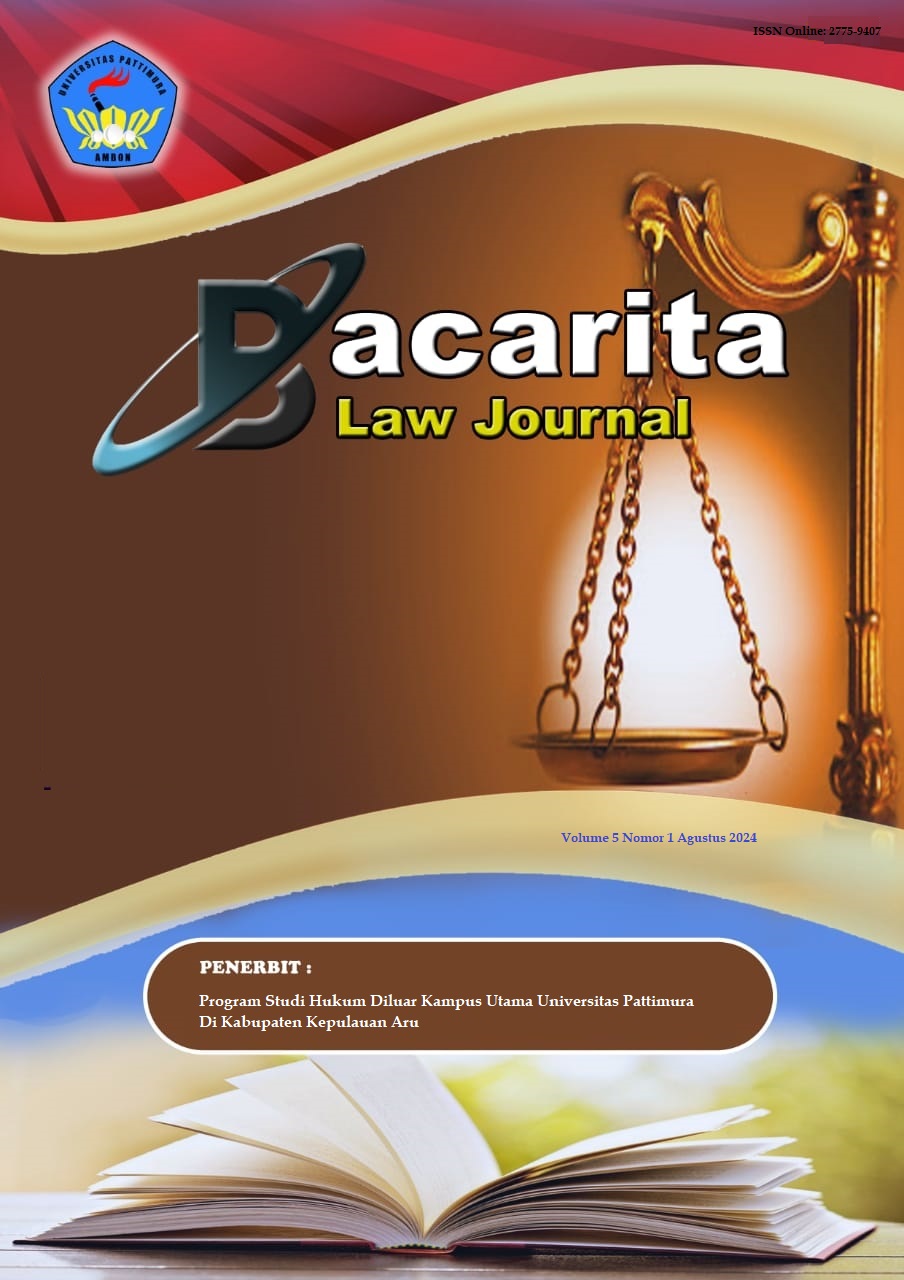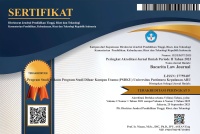Penerapan Diversi Tindak Pidana Anak Dalam Penggunaan Senjata Tajam
Abstract
Article 7 paragraph (2) of the SPPA Law limits the implementation of diversion only to criminal acts which are punishable by a sentence of less than seven years, so that criminal acts which are punishable by more than seven years cannot be attempted. This article discusses the application of diversion at the investigation, prosecution and evidentiary stages and the judge's considerations in Decision Number: 15/pid.sus.anak/2021/PN.BGR in the case of possession of sharp weapons. The author uses normative juridical research methods. The results of this research conclude that diversion must be carried out during the investigation, prosecution and evidence stages in court. The judge was of the opinion that in this case diversion could not be applied considering that the child was charged under Article 2 paragraph 1 of the Emergency Law of the Republic of Indonesia no. 12 of 1951 with a penalty of 10 years in prison, so that child offenders cannot be diverted. The conditions for diversion limit implementation, so that if the perpetrator and victim agree to reconcile, diversion cannot still be carried out. Therefore, it is necessary to have provisions that can give authority to Law Enforcement Officials to carry out diversion based on an objective assessment and agreement between the parties, even though this case is punishable by a sentence of more than 7 years in prison.
Downloads
References
Jurnal
Andrianto, Hendricus, Pujiyono, dan Nur Rochaeti, “Implementasi Diversi Terhadap Anak yang Berhadapan Dengan Hukum di Polres Pati”, Diponegoro Law Journal, Vol. 5, No. 3. 2016.
Johari dan Muhamad Arif Agus, “Analisis Syarat Diversi Dalam Sistem Peradilan Pidana Anak”, Journal of Correctional Issues Vol.4 No. 2. 2021.
Rachmat, Azwad Hambali, “Penerapan Diversi Terhadap Anak Yang Berhadapan Dengan Hukum Dalam Sistem Peradilan Pidana”, Jurnal Pidana, Vol. 13, No. 1. 2019.
Ratna, Diah Sari Hariyanto dan Gde Made Swardhan, “Optimalisasi Pelaksanaan Diversi Dalam Sistem Peradilan Pidana Anak Yang Berorientasi Pada Restorative Justice Di Kota Denpasar”, Jurnal Legislasi Indonesia, Vol. 18 No. 3 2021.
Susanti, Hera. “Diversi Dalam Sistem Peradilan Pidana Anak Di Indonesia Dan Tinjauannya Menurut Hukum Islam”, Jurnal Legitimasi, Vol. VI No. 2. 2017.
Sumakul, A. E. “Independensi Kejaksaan Dalam Melakukan Penyidikan Tindak Pidana Korupsi Menurut Undang-Undang Nomor 31 Tahun 1999 Jo. Undang-Undang Nomor 20 Tahun 2001”. Lex Crimen, Vol. 7, No. 5, 2018.
Buku
Achjani, Eva Zulfa, Keadilan Restoratif. Jakarta: Fakultas Hukum UI. 2009.
G. R. Raco, Metode Peneitian Kualitatf Jenis, Karakteristik dan Kaunggulan. Jakarta : Grasindo, 2010.
Gultom, Maidin. Perlindungan Hukum Terhadap Anak dalam Sistem Peradilan Pidana Anak di Indonesia. Bandung : Refika Aditama, 2008.
Marsaid, Perlindungan Hukum Anak Pidana Dalam Perspektif Hukum Islam (Maqasid Asy-Syari’ah), Palembang: NoerFikri. 2015.
Prakoso, Abintoro. Pembaruan Sistem Peradilan Pidana Anak. Yogyakarta: Laksbang Grafika, 2012.
R. Wiyono, Sistem Peradilan Pidana Anak di Indonesia. Jakarta: Sinar Grafika, 2016.
Yesmil , Anwar dan Adang, Sistem Peradilan Pidana. Bandung: Widya Padjadjaran, 20110.
Yudi, Kristiana. Independensi Kejaksaan dalam Penyidikan Korupsi. Bandung: Citra Aditya Bakti, 2011.
Online/World Wide Web dan Lain-Lain
Kurniaty, Yulia. Johny Krisnan dan Heni Hendrawati, “Hambatan Pelaksanaan Diversi Dalam Penyelesaian Tindak Pidana Anak Di Tingkat Pengadilan”, The 4th University Research Coloquium (2016)diaksesmelaluilamanhttps://publikasiilmiah.ums.ac.id/bitstream/handle/11617/7676/Humanoria_5.pdf?sequence=1.
Rasban, Supardji. “Kasus Kekerasan Terhadap Anak di Indonesia Capai 33%,” Media Indonesia, diakses melalui https://mediaindonesia.com/nusantara/190263/kasus-kekerasan-terhadap-anak-di-indonesia-capai-33.
Copyright (c) 2024 Mila Istiqomah, L Alfies Sihombing, Astim Rianto

This work is licensed under a Creative Commons Attribution-NonCommercial 4.0 International License.
Authors who publish their manuscripts in this Journal agree to the following conditions:
- The copyright in each article belongs to the author, as well as the right to patent.
- Authors are able to enter into separate, additional contractual arrangements for the non-exclusive distribution of the journal's published version of the work (e.g., post it to an institutional repository or publish it in a book), with an acknowledgment of its initial publication in this journal.
- Authors are permitted and encouraged to post their work online (e.g., in institutional repositories or on their website) prior to and during the submission process, as it can lead to productive exchanges, as well as earlier and greater citation of published work.
- Authors have the right to self-archiving of the article (Author Self-Archiving Policy)















